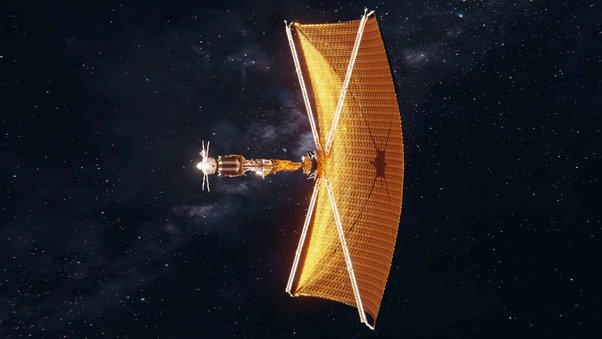With the advancement of technology, space exploration has become more accessible and achievable. One such exciting development is the concept of solar sails. Solar sails use the subtle pressure of sunlight or photons to propel a spacecraft, allowing it to move forward without fuel. This technology has captured the interest of scientists and space enthusiasts alike, as it promises a new era of deep-space exploration. Recently, a giant solar sail has been developed that will propel a tiny spacecraft to intercept and study a target. In this blog post, we will explore the science behind solar sails and their potential for space exploration. We will also discuss the recent development of a giant solar sail and the exciting possibilities it holds for the future of space travel.
Description of the proposed giant solar sail to propel a tiny spacecraft.
The proposed giant solar sail is a breakthrough technology that will allow a tiny spacecraft to travel long distances in space. The concept of a solar sail is not new, but this one is exceptional because of its size. The solar sail, which is about the size of a football field, is made up of ultra-thin layers of reflective material that can capture photons from the sun and use them as a source of propulsion. The sail is designed to be extremely lightweight, enabling it to be carried by a small spacecraft. It is estimated that the sail will generate enough thrust to propel the spacecraft to speeds of up to 20 kilometers per second. The sail’s deployment will be a critical moment for the mission as it will determine the success of reaching the target. The giant solar sail may prove to be a game-changer in the exploration of space by enabling us to travel to distant locations never before possible.
Background information on the spacecraft’s mission to intercept and study a passing asteroid.
NASA’s latest mission to explore space involves sending a tiny spacecraft to intercept and study a passing asteroid. But how does this work exactly? The spacecraft will be equipped with a giant solar sail, which will harness the power of the sun’s energy to propel the spacecraft towards the asteroid.
The sail is made of a thin, reflective material that can capture the sunlight and use it as a source of momentum. As photons from the sun’s rays collide with the sail, the momentum from the collision is transferred to the spacecraft, helping it move forward. While this method doesn’t provide as much thrust as traditional rocket engines, it can provide a continuous source of acceleration for the spacecraft without requiring any additional fuel.
This mission is not only unique in its use of a solar sail, but also in the size of the spacecraft itself. Measuring in at a mere 6 meters across, the spacecraft will be the smallest ever to visit an asteroid. However, its compact size will allow for more maneuverability and flexibility when studying the asteroid up close.
Overall, this mission is an exciting step forward in space exploration technology. By using a solar sail to power a tiny spacecraft, NASA is paving the way for future missions that may require more efficient and sustainable sources of propulsion.
Explanation of how solar sail propulsion works and why it’s a promising technique.
Solar sail propulsion is a revolutionary technology that has the potential to change the way we explore space. The basic principle behind this technique is to harness the momentum of photons emitted by the sun, allowing spacecraft to propel themselves forward without the need for fuel.
Solar sails are made up of incredibly thin and lightweight sheets of material, which are attached to the spacecraft. These sails absorb solar energy, causing photons to bounce off them and in turn, propelling the spacecraft forward.
The benefits of solar sail propulsion are numerous. Firstly, it allows for much greater distances to be covered than traditional chemical rockets, which are constrained by fuel limitations. Secondly, it reduces the overall mass of the spacecraft, enabling it to be launched more easily and at a lower cost. Finally, it has the potential to facilitate long-term missions, as solar sails need very little maintenance or refuelling.
Although solar sail technology is still in its infancy, it has been successfully tested in a number of missions, including Japan’s IKAROS spacecraft in 2010 and The Planetary Society’s LightSail 1 in 2015. With the recent announcement of a giant solar sail project, there is no doubt that this technique will continue to be refined and developed, paving the way for new and exciting missions in the future.
Discussion of the challenges of navigating and maintaining a solar sail system in space.
Achieving successful navigation and maintenance of a solar sail system in space comes with unique challenges. Firstly, unlike traditional propulsion systems which rely on fuel, solar sails depend on the energy from the sun. This means that the direction and intensity of the sun’s radiation could have a significant impact on the spacecraft’s movement, and therefore, require constant monitoring and adjustment. Additionally, maintaining the structural integrity of the solar sail layers against physical stress, such as solar flares, micrometeorites, and other debris in space, requires the use of resilient materials and advanced design considerations. Furthermore, communication with the spacecraft becomes an issue due to the distance from Earth and the need for power-efficient communication systems. Despite these challenges, recent technological advancements have enabled scientists to make significant strides in developing effective solar sail propulsion systems for space exploration missions.
Overview of the spacecraft’s design and instrumentation for studying the asteroid.
The spacecraft, named the NEA Scout (Near-Earth Asteroid Scout), will be propelled by a giant solar sail that measures about the size of a tennis court. The solar sail will harness the power of sunlight to create a steady acceleration that will allow the tiny spacecraft to reach its destination in a relatively short amount of time.
Once it arrives at the target asteroid, the NEA Scout will use a suite of instruments to study the asteroid’s physical and chemical properties. These include a small infrared camera that will capture images of the asteroid’s surface, as well as a radiometer that will measure the asteroid’s temperature. Additionally, the spacecraft will use a laser altimeter to map the asteroid’s topography, and a magnetometer to study its magnetic field.
Overall, the NEA Scout represents an exciting new development in asteroid exploration, allowing us to study these objects up close and gain a better understanding of their properties and origins in the solar system.
Details on the asteroid’s characteristics and why it’s of interest to scientists.
The asteroid “3200 Phaethon” will be the target of the upcoming solar sail mission. Phaethon is an intriguing object as it behaves like a comet, yet looks like an asteroid. It is also known to pass very close to the Sun, which makes it a valuable target for studying the effects of solar radiation on its surface. Additionally, Phaethon has been observed to produce a meteor shower known as the Geminids, which is one of the most reliable annual meteor showers visible from Earth. By studying Phaethon up close, scientists hope to gain a better understanding of the composition and evolution of small, rocky bodies in our solar system, as well as the mechanics behind meteor showers. The data collected from the solar sail mission will also provide valuable insights for future asteroid mining missions and planetary defense strategies.
Potential scientific discoveries that could be made through the asteroid study.
The study of this asteroid using the solar sail technology presents a great opportunity for scientific discoveries in various fields. Firstly, understanding the composition and nature of this asteroid can provide insights into the formation of our solar system. Additionally, the study of asteroids helps scientists better understand the risk posed by near-Earth objects and gives them the knowledge to develop strategies to avoid or mitigate the impact of such objects on Earth. Moreover, the data gathered from exploring the asteroid can facilitate the development of technologies for future space missions, particularly for deep space exploration and asteroid mining. Overall, this mission has the potential to make significant contributions to our scientific knowledge and technological advancements.
Discussion of the future possibilities for solar sail technology in space exploration.
Solar sail technology presents numerous advantages for space exploration in the future. With the ability to harness the energy from the sun to propel spacecraft, solar sails could take us further than ever before. In addition to being a clean and cost-effective form of propulsion, solar sails could potentially be used for long-distance missions, such as interstellar travel.
One potential application for solar sail technology is in the study of asteroids and comets. By using a solar sail to propel a spacecraft towards these celestial bodies, we could potentially study them up close and gain a better understanding of their composition and potential impact risk to Earth. Solar sails could also be used to explore planets and their moons, giving us a better understanding of the solar system as a whole.
Another potential use for solar sails is in the search for extraterrestrial life. By using a solar sail to propel a spacecraft towards another star system, we could potentially send probes to investigate exoplanets and search for signs of life. This type of mission would require a significant amount of time, but the cost of using solar sails could make it feasible for the first time.
Overall, the future possibilities for solar sail technology in space exploration are exciting and vast. As technology continues to improve, we may see more missions that utilize this unique form of propulsion to explore our solar system and beyond.





